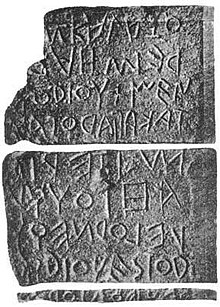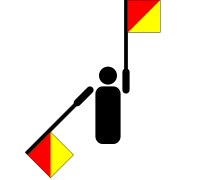K
The k (uppercase K, noun ka, plural kas) is the eleventh letter and the eighth consonant of the Spanish alphabet and the basic Latin alphabet. In Spanish it represents an obstructive, plosive, velar and deaf consonant sound; and in general it is used in words that do not have the same origin as the Romance languages.
History
| Egyptian hierophic | Proto-semitic (open hand) | Fellowship Kap | Greek Kappa | Etrusco K | Latin K | ||
|---|---|---|---|---|---|---|---|
|  |  |  |  |
The graph of the 'K' comes from the letter kappa, which was taken from the Semitic kap in the form of an open hand. This, in turn, was possibly adapted by the Semites who lived in Egypt, from a hieroglyphic hand, which represented the sound of the &# 39;D'. The Semites assigned this the phonetic value /k/, which represents the actual sound of the 'K', since "hand" in their language it began with this sound.
In early Latin inscriptions, the letters 'C', 'K' and 'Q' they were used to represent the sound /k/ and /g/, which did not differ in writing. The 'Q' was used to represent /k/ or /g/ before a back vowel (/u/, /o/), the 'K' before /a/, and the 'C' in the other cases (/e/, /i/). Later, the C and its variant, the G, replaced most of the uses that were put to the K and Q. The K survived only in some fossilized forms.
When the Greek words were taken over by Latin, the Kappa was changed to the graph that today would be "C", with a few exceptions, such as the praenomen "Kaeso". Some words from other alphabets were also transliterated with C, so in Romance languages the K only exists in words from other language groups.
Celtic also chose C over K, and this influence continued into Old English, making English today the only Germanic language to use both C and K, although Dutch uses C in words of Latin origin distinguishing it from the K with a softer sound.
Many English linguists prefer to reverse the transliteration process from C to K when writing Greek proper names, so many of these names that in Spanish are accepted only with 'C', in English are can be spelled with 'K', such is the case of Hecate ("Hécate"), which can be spelled Hekate.
Uses
The "K" capital represents
- The chemical element, the potassium.
- To the carat of goldsmithy
- The amino acid, the Lysine.
- In geometry, to the constant proportionality.
- In physics:
- To the temperature unit, the Kelvin.
- To the Knudsen Number.
- To the constant balance.
- To the unit to measure the waves, the Kayser.
- In particle physics, a Kaon.
- In graph theory, to the full graph.
- In baseball, the punch or 'strikeout'
- In banking and computer language abbreviations, numbers are represented in a non-standard notation replacing the last three zeros of the general number with K, as in 30K by 30,000.
The "k" lowercase represents
- In the International Unit System (SI), the SI prefix for a thousand is kilo-, officially abbreviated as k: for example, prefixed to metro/meter or its abbreviation m, kilometer or km, means a thousand meters.
- To the occlusive sound watch deaf.
- In physics:
- To the prefix which means kilo ("1000 times").
- Boltzmann Constant.
Phonetic
The 'K' it has in Romance and Germanic languages a voiceless velar plosive sound /k/. This is in Spanish, the same sound that 'C' has, when it goes before "a", "o", "u"; and the one with the 'Q' when it forms the digraph "qu" (the latter only appears before the vowels "e" and "i").
Rules for its orthographic use
As already mentioned, in Spanish they are written with 'K' a small number of words that have a different provenance than the Romance languages, that is, they have no Greek or Latin origin, except for a few such as "kilo". Among these, the words can be mentioned:
- "Kiosco": Preferably written with Q; it originates from the Persian and arrived in Spanish through French.
- "Koala": from the language dharug or Sydney language, an Aboriginal language extinct from Australia.
- "Kril": Norwegian.
- "Kiwi": from the Maori language.
- "Kermés": Dutch kerkmis, kerk (chuckles) and My (misa), literally "churchfestival."
- "Karate", "kamikaze", "kimono": Japanese.
- "Anorak": Greenland.
- "Yak": Tibetan.
In addition to many others that are proper names: Katherin, Kevin, Krissel, Kyle, New York, Iraq, Mark, Zack, Rick etc. Hispanicized proper names such as Carla and Carina also admit the spelling "k" (Karla, Karina, Karen, Kenya).
Computer Codes
| Character | K | k | ||
|---|---|---|---|---|
| Name Unicode | LETRA LATIN K MAYUSCULA | LATIN K MINUSCULA LETRA | ||
| Codification | decimal | hexadecimal | decimal | hexadecimal |
| Unicode | 75 | U+004B | 107 | U+006B |
| UTF-8 | 75 | 4B | 107 | 6B |
| Numerical character reference | "#75; | K | "#107; | k |
| EBCDIC family | 210 | D2 | 146 | 92 |
| ASCII | 75 | 4B | 107 | 6B |
- ↑ Also for ASCII-based encoding, including DOS, Windows, ISO-8859 and Macintosh encoding families.
In computing, the symbol "k" de kilo, to designate the kilobyte, which may well be equal to 1024 bytes if it has a hexadecimal base, and is symbolized "1 KiB"; or it can be equal to 1000 bytes if using a decimal base, as is used by optical media producers, and symbolized "1 KB".
Alternative representations
In the aeronautical phonetic alphabet it is assigned the word Kilo.
In morse code it is: -•- , and also means "change" (when a message has finished transmitting).
In the English language, it is used as an abbreviation for the expression ok. Colloquially, it is used as an abbreviation of the expression "that", in the form of a question.
Related lyrics
- K к: Russian letter Ka.
- Κ κ: The Greek letter Kappa
Contenido relacionado
The slaughter
Socotri language
Yuruna languages




